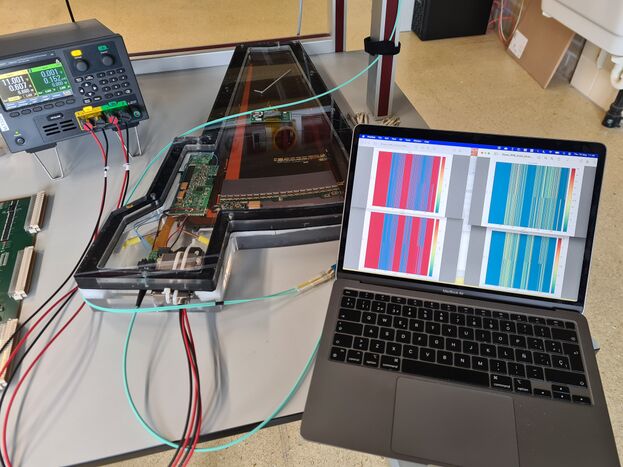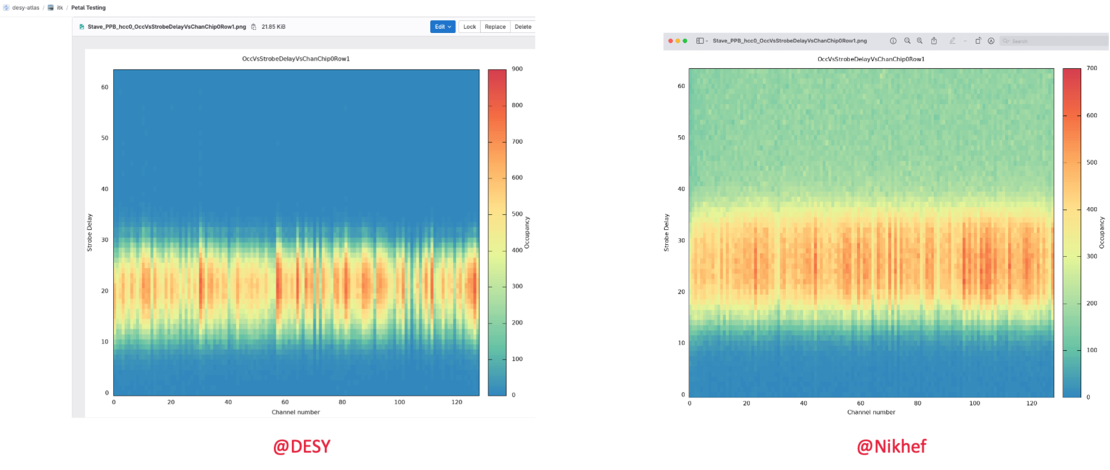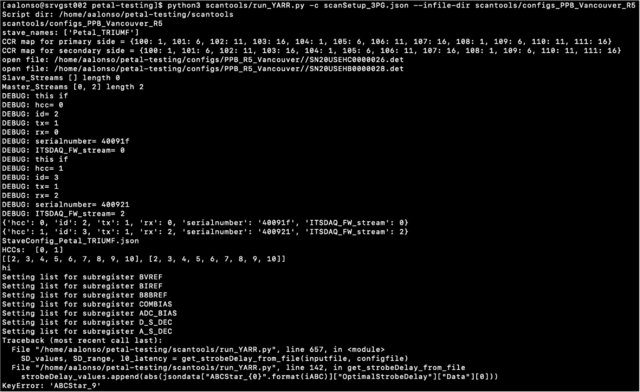FELIX instructions for Petals
Author: Andrea García Alonso aalonso@nikhef.nl
Note on repositories: The YARR repo needs to be (at least) on commit 2169a65b63c94e5eda9789908b62eab325dffb3d: https://gitlab.cern.ch/desy-atlas/itk/YARR/-/blob/2169a65b63c94e5eda9789908b62eab325dffb3d
Main instructions in this page were taken from DESY repo https://gitlab.cern.ch/desy-atlas/itk/petal-testing
petal-testing/scantools is a copy of the repo https://gitlab.cern.ch/itk-strips-at-sr1/scan-tools-for-yarr, so be sure it's on the latest commit, branch EC-DESY
NOTE: For Nikhef, the FELIX server should be renamed in the json files in /scantools/configs_PPB_Vancouver_R5:
"Server_config": {
"felix_host": "srvgst002"
},
The FELIX card sits in the srvgst002 server, and inside of it /home/aalonso/petal-testing is the working path. This info should also be displayed correctly in run_YARR.py and all the json files in /scantools/configs_PPB_Vancouver_R5.
How to configure a petal
Turn ON the LV PSU: 11V.
On TERMINAL 1
cd into the petal-testing directory and then execute the following commands:
- Setup the FELIX dependencies:
source dependencies/setupFELIX.sh
- Initialize the FLX card:
flx-init
It's normal if it says that all the channels are not aligned even if at least one actually is, we don't know why, but SR1 with staves sees the same.
- Invert the polarity (for lpGBTv1):
flx-config set GBT_RXPOLARITY=0xFFFFFFFF
- Verify the status of the PODs:
flx-info POD
- Check that all connected links are aligned:
flx-info GBT
If testing the PPB R5 Vancouver Petal:
- Configure the elinks on your FELIX card:
source configs/elinks/elinks_petal_R5_640Mbs.sh
- Check your config:
elinkconfig
Click on Read Cfg, then you can Quit.
- Push the lpGBT config to the petal chipset:
fice -G0 -I71 configs/lpgbt/lpgbt_PT_M_LH_V1_Pri_hex.cnf
If this command takes a long time, it's because of the LV PSU, probably due to have been providing power for a long time.
- Verify this has worked (you should see the line "Compared 336 values, found 0 differences"):
fice -G0 -I71 -C configs/lpgbt/lpgbt_PT_M_LH_V1_Pri_hex.cnf
- Start FELIXCore and don't close this terminal:
startFelixcore
On TERMINAL 2
On a second remote terminal session cd into the petal-testing directory and then execute the following commands:
- Configure the YARR dependencies:
source dependencies/setupYARR.sh
- Activate the AMAC:
write_amac_ppb 9 1 0 0
This will increase the current in the LV PSU, typically from 165 mA to 405 mA, at least these are the numbers at Nikhef with the R5 Vancouver petal. It's important to check this change in the consumption, since it confirms there's communication with the chips. In the terminal running Felixcore, a new line will appear saying "Opening DEVICE 0 for the To-FLX thread". NOTE: If the consumption doesn't change and in the Felixcore terminal we don't get the new line, it means that the AMAC didn't get activated. Check the IPs, since that would be an IP address problem.
Turn ON the CAEN HV PSU: 200μA compliance for R5 module (full petal is different): 500V. It will ramp up at 10V/s. The consumption in the HV PSU will rise till 115 μA when the 500V are reached.
- Confirm there's communication with the HCCs via a register dump scan:
python3 scantools/run_YARR.py -c scanSetup_regDump.json --infile-dir scantools/configs_PPB_Vancouver_R5execute it twice!! (once per HCC)
After the 2nd time, there shouldn't be lines like "There were no results for chip Stave_PPB_hcc1".
Also: after the first register dump scan, the current in the LV PSU will increase from 405 mA to 514 mA, and Felixcore will show the lines "Subscription from endpoint 127.0.0.1:37645 for elink 0" and "Subscription from endpoint 127.0.0.1:39225 for elink 2". After the second regsiter dump scan the current will increase from 514 mA to 605 mA, and Felixcore will show the lines "Subscription from endpoint 127.0.0.1:42045 for elink 0" and "Subscription from endpoint 127.0.0.1:46479 for elink 2".
FELIX DAQ Petal Scans
Trim Scan
The trimScanWithRange optimizes the trim and threshold values of the chip at the same time, thus this scan takes a while (around 45'): python3 scantools/run_YARR.py -c scanSetup_trim.json --infile-dir scantools/configs_PPB_Vancouver_R5
This scan uses the following json files:
- to configure which scans to use: /petal-testing/scantools/configs_PPB_Vancouver_R5/scanSetup_trim.json
- to define the actual scan (scan config): /YARR/configs/scans/star/std_trimScanWithRange.json
So if you want to use a different scan from YARR, you need to change it in /scantools.
In /data, you should now find a subdirectory called XXXXXX_std_trimScanWithRange, with TrimDacVsThreshold plots looking like the following ones (for HCCs 0 and 1):
For an unbiased R5 Petal:
- UnBiased PPB-R5 Triumph petal plots (only LV on)
Check that for both HCCs, the StarTrimDACResult JSON files exist.
Strobe Delay Scan
Before performing the scan, enter the results of the previous trim scan in the configuration of the strobe delay (SD) scan:
1) Important: Edit the scantools/configs_PPB_Vancouver_R5/scanSetup_SD.json and enter the previous run number in the field "input_trim_from_run": "/XXXXXX".
2) Run the scan (this one takes 5') using the command: python3 scantools/run_YARR.py -c scanSetup_SD.json --infile-dir scantools/configs_PPB_Vancouver_R5
NOTE: In my case, the run_YARR.py file had some issues for the strobe delay scan: lines 121 and 156 contained "for iABC in range(10):" trying to access 10 ABCs, when there's only 9. I modified them to "for iABC in range(9):"
In the output directory, the OccVsStrobeDelayVsChan plots should look somewhat like this:
These two plots (scans with no HV) should have been the same. The occupancy scale differs, which could partially explain the difference in colors for strobe delays above 30, but for the channel distribution differences it might be normal that each scan adjusts differently, let's see how the rest of scans go. Maybe the external light conditions could explain the difference. The Nikhef petal was tested without any cover from the light.
If everything worked correctly, you should see the XXX_StarStrobeDelayResult.json files in the /data folder.
3 Point Gain Scan
1) Important: Edit the scantools/configs_PPB_Vancouver_R5/scanSetup_3PG.json and enter the corresponding run numbers in the fields "input_trim_from_run": "/XXXXXX" and "input_strobeDelay_from_run": "/XXXXXX".
2) Run the scan (this one takes 5') using the command: python3 scantools/run_YARR.py -c scanSetup_3PG.json --infile-dir scantools/configs_PPB_Vancouver_R5
NOTE: Also in this scan, I got the same issue with the IDs of the ABC chips (as happened with the strobe delay scan).
The responseCurve plots should contain three points and look like this:
PLOTS
Response Curve Scan
1) Important: Edit the scantools/configs_PPB_Vancouver_R5/scanSetup_rcurve.json and enter the corresponding run numbers in the fields "input_trim_from_run": "/XXXXXX" and "input_strobeDelay_from_run": "/XXXXXX".
2) Run the scan (this one takes 5') using the command: python3 scantools/run_YARR.py -c scanSetup_rcurve.json --infile-dir scantools/configs_PPB_Vancouver_R5
NOTE: Scan failed for me because petal-testing/dependencies/YARR/configs/scans/star/std_responsecurve.json didn't exist. Comparing with the devel_SR1 branch, I saw this file contains for them the same as the file std_npointscan.json which does exist in my directory. So I copied this file and renamed it as std_responsecurve.json (so now both exist in petal-testing/dependencies/YARR/configs/scans/star/ with equals contents which is not right). Then J-H sent me the correct values for the loops section, which is the only difference between the two json files (3PG and rcurve).
The responseCurve plots should contain 16 points and look like this:
Noise Occupancy Scan
1) Important: Edit the scantools/configs_PPB_Vancouver_R5/scanSetup_NO.json and enter the corresponding run numbers in the fields "input_trim_from_run": "/XXXXXX" and "input_strobeDelay_from_run": "/XXXXXX".
2) Run the scan (this one takes 5') using the command:python3 scantools/run_YARR.py -c scanSetup_NO.json --infile-dir scantools/configs_PPB_Vancouver_R5
The OccupancyMap plots should look like this:
How to turn off the system
1) Turn OFF the (500V) CAEN HV PSU. It will do a power ramp of 10V/s till full shut down.
2) With felixcore running, go to the felix server and do source dependencies/setupYARR.sh and then turn all off: write_amac_ppb 9 0 0 0
3) Turn OFF the (11V) LV PSU.





